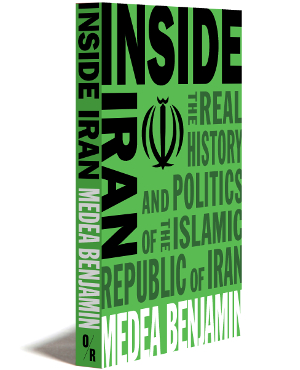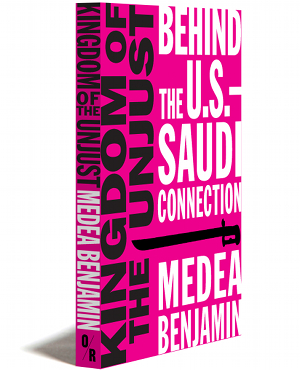
Buy This Book
|
Paperback: $18/£13
|
E-book: $10/£7
|
Print + E-book: $24/£17
|
About the Book
In 1979, the Iranian Revolution brought a Shia theocracy to the 80 million inhabitants of the Middle East’s second largest country. In the decades since, bitter relations have persisted between the U.S. and Iran. Yet how is it that Iran has become the primary target of American antagonism, when Saudi Arabia, a regime that is even more repressive, remains one of America’s closest allies?
In the first general-audience book on the subject, Medea Benjamin elucidates the mystery behind this complex relationship, recounting Iran’s history from the pre-colonial period, through the CIA-engineered coup that overthrew the country’s democratic leadership in 1953, to its emergence as the one nation Democrats and Republicans alike regularly unite in denouncing. Benjamin draws upon her firsthand experiences with Iranian politicians, activists, and everyday citizens to provide a deeper understanding of the complexities of Iranian society and the nation’s role in the region.
Tackling the contradictions in Iran’s system of government, its religiosity, and its citizens’ way of life, Inside Iran makes short work of the inflammatory rhetoric surrounding U.S.-Iranian relations, and presents a realistic and hopeful case for the two nations’ future.
Illustrated with maps and photographs • Index
256 pages • Paperback ISBN 978-1-682191-40-8 • E-book 978-1-682191-42-2
About the Author
 |
Medea Benjamin is one of America’s best-known 21st-century activists. Co-founder of CODEPINK and the fair trade advocacy group Global Exchange, she is the author of Drone Warfare (OR Books, 2012) and Kingdom of the Unjust: Behind the U.S.–Saudi Connection (OR Books, 2016) and has played an active role in the Green Party. A frequent contributor to Alternet, she has a Master’s Degree in both public health and economics. In 2012, she was awarded the U.S. Peace Memorial Foundation’s Peace Prize; she is also recipient of the 2014 Gandhi Peace Award and the 2010 Martin Luther King, Jr. Peace Prize from the Fellowship of Reconciliation. She is a mother and grandmother, and currently lives in Washington, D.C. |
Table of Contents
Table of Contents
Introduction
Chapter 1: Iran Before the 1979 Revolution
Chapter 2: The Islamic Revolution Shocks the World
Chapter 3: The Struggle for Human Rights
Chapter 4: “Social Deviants”: Gays, Prostitutes, Drugs, and Alcohol
Chapter 5: Religious Freedom, for Some
Chapter 6: The Paradoxical Status of Iranian Women
Chapter 7: The Iranian Economy After Decades of Sanctions
Chapter 8: Iran’s Relations with the US and the West
Chapter 9: Iran in the Middle East and Beyond
Chapter 10: The Way Forward
Read an Excerpt
from the book:
What Have Been the Effects of Sanctions?
It’s a wonder that the Iranian economy functions as well as it does, given the crippling restrictions it is been subjected to since the time of the 1979 revolution. Sanctions started with the U.S. Embassy hostage crisis, when the Carter administration banned Iranian oil imports, froze $12 billion in Iranian government assets in the United States, and imposed an embargo on travel to Iran. Some of these restrictions were lifted when the hostages were released, but the Reagan administration, after the 1983 bombing of a U.S. Marine compound in Lebanon, blocked World Bank loans to Iran and later banned all US imports from Iran.
Starting in 1995, the Clinton administration used sanctions to punish Iran for links to groups it defined as terrorists—Hezbollah, Hamas, and Palestinian Islamic Jihad. The administration placed a total trade and investment embargo on Iran. Congress went even further with a 1996 sanctions bill pressuring foreign companies to refrain from investing in Iran’s oil and gas industry. In 2005, the Bush administration froze the assets of individuals and firms, including Russian and Chinese companies, that it deemed involved in Iran’s “support for terrorism” and its nuclear and missile programs. It also prosecuted individuals and companies changed with selling weapons to Iran.
The Obama administration continued and intensified these sanctions. Congressional measures passed in 2010 targeted insurance companies that insured Iranian shipping, and squeezed the oil and gas sector further. Sanctions had already cobbled Iran’s refineries, forcing this oil-rich nation to import 30 percent of its refined gasoline. New bans targeted non-U.S. firms supplying Iran with refined petroleum products.
Through the U.S. Treasury Department’s Office of Foreign Assets Control, billions of dollars in penalties have been inflicted on U.S. branches of foreign-owned banks for sanctions violations. As a result, many banks adopted a “de-risking” strategy, refusing to conduct even permissible business with Iran for fear of coming under regulatory scrutiny. U.S. measures also greatly restricted the access of Iranian banks to the global financial system, as well as its Central Bank’s access to its own $150 billion of foreign exchange money that the U.S. froze—funds that were only released after the nuclear deal was signed.
By 2010, other major European countries joined U.S. sanctions in a concerted effort to force Iran to cease its nuclear program. These crippling measures included a ban on dealings with Iran’s Central Bank, a ban on imports of Iranian oil, and a ban on trade in gold, diamonds, and precious metals. In 2012, the European Union joined the U.S. effort to close off Iran’s oil trade. The pressure further increased when Iranian banks were shut out of the SWIFT global electronic payments system.
A look at the website of the Treasury Department’s Office of Foreign Assets Control shows the vast concoction of bureaucratic punishments the U.S. government cooked up over the years to squeeze Iran economically. They include 27 Executive Orders, 11 Statutes, 23 Interpretive Guidance documents. They are meant to scare U.S. companies from even contemplating deals with Iran, but they are also meant to influence foreign companies around the globe.
Many Iranians interpreted these draconian measures not as a way to force a nuclear deal but as an insidious international plan to weaken Iran to the benefit of pro-Western governments in the region, like Israel and Saudi Arabia. President Ahmadinejad called them “the heaviest economic onslaught on a nation in history. Every day, all our banking and trade activities and our agreements are being blocked.”
An Iranian women’s rights activist reflected, “The sanctions started 32 years ago. I don’t know of any people who have suffered these kinds of sanctions over such a long period, except Palestinians and Cubans. They toppled our democratically elected government in 1953. After the revolution, they helped prolong the war with Iraq, and as such helped push the Iranian government to the right. I don’t know what the West has gained from all this. I only ask: Why do they hate us so much?”
One of the most difficult issues for businesses has been access to financing, especially for smaller businesses. Thousands of businesses were forced to close, leaving workers stranded. With a constrained economy and lack of investment, many educated Iranians left to seek employment abroad, leading to a brain drain among some of the nation’s brightest young people.
Economic sanctions are blunt policy instruments that often harm the civilian population far more than the state. In the case of Iran, sanctions destroyed the purchasing power of ordinary citizens. Prices for food, rent, fuel, and other basic necessities rose steeply—by 100% in some instances. Despite subsidies intended to help the poor, in 2012 prices for staples such as milk, bread, yogurt, and vegetables doubled, prompting food riots. Middle class families began living on rice and beans. Many medicines for serious illnesses became scarce or prohibitively expensive. Theft, something rare in Iran, shot up. Imported goods became unaffordable, and the government was forced to embark on an emergency campaign to substitute imports with domestic production.
Sanctions have also led to greater corruption. In 2016, Transparency International ranked Iran among the world’s more corrupt countries, with a rating of 131 out of 176 nations. Often the only way to get basic goods is through the black market, so government entities and businesses that control the black market reap windfall profits. Paying bribes to get access to scarce goods or to reduce taxes, fees, and custom duties became routine. And the hardline Islamic Revolutionary Guards Corps, with its unfair advantages over private businesses, gained control over vast sectors of the country’s economy. This also means that, while one of the goals of sanctions is to weaken the government, sanctions actually strengthen the government’s hand vis-a-vis the public. People become more dependent on the government for their economic survival.
Sanctions and corruption have also led to a yawning wealth gap between the rich and the poor that mirrors the pre-revolutionary society of haves and have-nots. When Mahmoud Ahmadinejad was president, he complained that 60% of the nation’s wealth was controlled by just 300 people. Luxury apartments and fancy cars line the streets in the wealthy neighborhoods in North Tehran while families cram together in small, rented rooms in the poorer South Tehran. In the rural areas, especially areas depleted from drought, the poverty is even worse.
Another insidious, little-known effect of sanctions has been the environmental impact. Not only was Iran barred from selling its crude oil, but it was also barred from importing refined gasoline. This forced the country to quickly come up with a way to refine its own oil. The result was poor-quality oil, leading to tremendous air pollution in the cities and skyrocketing deaths from respiratory diseases. In Tehran, the days of “healthy air” dropped from 300 days in 2009 to 150 days in 2011. Air quality got so bad that there were days the capital city had to be shut down for people’s safety and health. As one reporter quipped, “No longer are Iranians merely suffering from the economic effects of wide-ranging international sanctions; they are literally choking to death from them.”
There is one silver lining from these decades of economic strangulation: a focus on self-reliance. Cut off from the outside, the government’s call for a “resistance economy” has promoted decades of local development and diversification. Iranian researchers and entrepreneurs have stepped in to fill the thousands of voids, showing the remarkable creativity and skill of the Iranian people. It has also helped preserve Iranian culture. Without a Starbucks on every corner, local tea shops thrive; without U.S. fast food chains, Iranians continue to appreciate their delicious Persian cuisine. There are pseudo-American chains like Pizza Hat and Kabooki Fried Chicken, but the restaurants are locally owned and operated.
In the Media
- “Another view of the war” — INSIDE IRAN author Medea Benjamin interviewed on Letters and Politics (4/4/2022)
- “Negotiations over the Iran nuclear deal are intertwined with the fate of Russia’s war in Ukraine” — INSIDE IRAN author Medea Benjamin featured on The Real News Network (3/31/2022)
- “How the US created a world of endless war” — INSIDE IRAN author Medea Benjamin featured in The Guardian (9/3/2021)
- “Dispelling Myths About Iran, Trump’s Bogeyman.” – MEDEA BENJAMIN on the The Real News (12/18/2018)
- MEDEA BENJAMIN on Donald Trump’s imposition of new sanctions on Iran at Loud & Clear (11/8/2018)
- MEDEA BENJAMIN on the Iran deal, Trump’s sanctions on Iran, and the US-Saudi alliance at RT Going Underground (10/4/2018)
- MEDEA BENJAMIN on the fracturing of US-EU relations over Trump’s Iran sanctions at Loud & Clear (9/27/2018)
- “Detailed information about contemporary Iran – the origins and functioning of its political system, its regional role, its citizens’ way of life.” – INSIDE IRAN reviewed in Survival: Global Politics and Strategy (9/27/2018)
- MEDEA BENJAMIN on the Trump administration’s push for regime change in Iran at Sputnik (9/27/2018)
- See MEDEA BENJAMIN, author of INSIDE IRAN, confront the head of Donald Trump’s Iran Action Group at The Real News (9/24/2018)
- MEDEA BENJAMIN on stopping America’s coming war on Iran at KPFA (7/31/2018)
- MEDEA BENJAMIN on Trump’s escalating war of words with Iran at KPFA Flashpoints (7/26/2018)
- “Tony Blair has made himself into a real mercenary out for hire.” MEDEA BENJAMIN on Tony Blair’s links with the brutal Saudi regime at The Real News (7/25/2018)
- MEDEA BENJAMIN discusses the Iran Nuclear Deal and the Korean peace process on the Thom Hartmann Program (6/26/2018)
- “Join us in building an economy that is not dependent on killing and maiming people to boost the profits of weapons manufacturers.” – MEDEA BENJAMIN in Nation of Change (6/11/2018)
- MEDEA BENJAMIN on the politics of North and South Korea, the Iran nuclear deal and the war in Yemen on KPFA (6/11/2018)
- “There will be no end to the Middle East conflicts without Iran” – MEDEA BENJAMIN interviewed in The Iranian (6/6/2018)
- MEDEA BENJAMIN on the Iran nuclear deal and the peace talks in Korea on RT’s Jesse Ventura show (5/14/2018)
- MEDEA BENJAMIN on Trump’s Foreign Policy and her new book INSIDE IRAN on The Zero Hour (5/14/2018)
- MEDEA BENJAMIN discusses the Iran nuclear deal and the peace process in Korea on TruthOut (5/11/2018)
- Alex Salmond interviews MEDEA BENJAMIN, author of INSIDE IRAN on RT (5/11/2018)
- “The peace movement must mobilize” – MEDEA BENJAMIN discusses the Iran Nuclear deal on Democracy Now (5/9/2018)
- MEDEA BENJAMIN discusses INSIDE IRAN and the Iran Nuclear deal on Faultlines (5/8/2018)
- “War is the way Americans learn geography” – MEDEA BENJAMIN discusses INSIDE IRAN at The New Humanist (5/7/2018)
- How the U.S. and Iran Got to This Tense Moment – an excerpt from INSIDE IRAN at Truth Dig (4/30/2018)
- Will the Iran nuclear deal survive Trump’s wrecking crew? MEDEA BENJAMIN in The Guardian (4/30/2018)
- MEDEA BENJAMIN author of INSIDE IRAN on Mike Pompeo’s regime change agenda at The Real News (4/16/2018)
- MEDEA BENJAMIN, author of the forthcoming INSIDE IRAN, on being American, Jewish, and banned from Israel, in The Guardian (1/17/2018)
- “10 Reasons the US Should Stick With the Iran Nuclear Deal.” MEDEA BENJAMIN in Alternet (10/16/2017)





